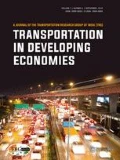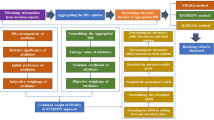Abstract
The climatic and environmental issues, rapid urbanisation, and technological developments in renewable energy in recent years have led to the rise of electric vehicles (EVs) for sustainable transportation. In the last decade or so, a set of situations have formed a way for electric mobility to enter India’s primary market, but it is still in its initial phase. Charging infrastructure can be considered a supporting pillar of this EV promotion scheme. The serviceability of a charging station is greatly affected by its location and the technology available. Hence, to fully incorporate EVs in the transportation sector, their charging technologies and stationing at appropriate charging sites must be analysed thoroughly. The selection of electric vehicle charging technology is a complex procedure. It can be decomposed into a decision-making problem with various criteria and alternatives to be considered simultaneously. This can be done using a multi-criteria decision-making (MCDM) technique. This study provides a fuzzy analytic hierarchy process (Fuzzy-AHP) framework to evaluate different criteria affecting our alternate technologies. Further, another MCDM Technique, VIKOR, is used to find solutions closest to the ideal condition and rank the alternate technologies. However, the selection of technology may vary from place to place. This study evaluates the criteria based on experts’ opinions. It is observed that the criteria reliability has the least weight, and charging time holds the maximum weight. This study favours battery swapping among all the available alternatives.

Source: NITI Ayog [21] (Government of India 2021)










Similar content being viewed by others
References
Andrenacci N, Ragona R, Valenti G (2016) A demand-side approach to optimal electric vehicle charging stations in metropolitan areas. Appl Energy 182:39–46. https://doi.org/10.1016/j.apenergy.2016.07.137
Aras H, Erdoǧmuş Ş, Koç E (2004) Multi-criteria selection for a wind observation station location using analytic hierarchy process. Renew Energy 29(8):1383–1392. https://doi.org/10.1016/j.renene.2003.12.020
Arora S, Abkenar AT, Jayasinghe SG, Tammi K (2021) Chapter 6 - charging technologies and standards applicable to heavy-duty electric vehicles. In: Arora S, Abkenar AT, Jayasinghe SG, Tammi K (eds) Heavy-duty electric vehicles. Elsevier, pp 135–155. https://doi.org/10.1016/B978-0-12-818126-3.00008-7
Barsali S, Ceraolo M, Giglioli R, Poli D (2015) Storage applications for Smartgrids. Electric Power Syst Res 120:109–117. https://doi.org/10.1016/j.epsr.2014.07.029
Beijing|Berlin|Brussels (2017) Emerging best practices for electric vehicle charging infrastructure Dale Hall, Nic Lutsey. In: The International Council on Clean Transportation, (October). Retrieved from www.theicct.org
Bräunl T, Harries D, Mchenry M, Wager G (2020) Determining the optimal electric vehicle DC-charging infrastructure for Western Australia. Transp Res Part D 84(January):102250. https://doi.org/10.1016/j.trd.2020.102250
Chang D-Y (1996) Applications of the extent analysis method on fuzzy AHP. Eur J Oper Res 95(95):649–655
Choudhary D, Shankar R (2012) An STEEP-fuzzy AHP-TOPSIS framework for evaluation and selection of thermal power plant location: a case study from India. Energy 42(1):510–521. https://doi.org/10.1016/j.energy.2012.03.010
Chung SH, Kwon C (2015) Multi-period planning for electric car charging station locations: a case of Korean expressways. Eur J Oper Res 242(2):677–687. https://doi.org/10.1016/j.ejor.2014.10.029
Davidov S, Pantoš M (2019) Optimization model for charging infrastructure planning with electric power system reliability check. Energy 166:886–894. https://doi.org/10.1016/j.energy.2018.10.150
Gamboa G, Munda G (2007) The problem of windfarm location: a social multi-criteria evaluation framework. Energy Policy 35(3):1564–1583. https://doi.org/10.1016/j.enpol.2006.04.021
Klein M, Lüpke L, Günther M (2020) Home charging and electric vehicle diffusion: agent-based simulation using choice-based conjoint data. Transp Res Part D: Transp Environ 88(October):102475. https://doi.org/10.1016/j.trd.2020.102475
Kumar PP, Parida M, Sekhar CR (2020) Developing context sensitive planning criteria for transit-oriented development (TOD): a fuzzy-group decision approach. Transport Res Procedia 48(May):2421–2434. https://doi.org/10.1016/j.trpro.2020.08.278
Kwiesielewicz M (1998) A note on the fuzzy extension of Saaty’s priority theory. Fuzzy Sets Syst 95(2):161–172. https://doi.org/10.1016/S0165-0114(96)00329-6
Langbroek JHM, Cebecauer M, Malmsten J, Franklin JP, Susilo YO, Georén P (2019) Electric vehicle rental and electric vehicle adoption. Res Transport Econ. https://doi.org/10.1016/j.retrec.2019.02.002
Lin MD, Liu PY, Yang MD, Lin YH (2021) Optimised allocation of scooter battery swapping station under demand uncertainty. Sustain Cities Soc 71(October 2020):102963. https://doi.org/10.1016/j.scs.2021.102963
Machura P, Li Q (2019) A critical review on wireless charging for electric vehicles. Renew Sustain Energy Rev 104(December 2018):209–234. https://doi.org/10.1016/j.rser.2019.01.027
Mehrjerdi H (2021) Resilience oriented vehicle-to-home operation based on battery swapping mechanism. Energy 218:119528. https://doi.org/10.1016/j.energy.2020.119528
Micari S, Polimeni A, Napoli G, Andaloro L, Antonucci V (2017) Electric vehicle charging infrastructure planning in a road network. Renew Sustain Energy Rev 80(May 2016):98–108. https://doi.org/10.1016/j.rser.2017.05.022
Mirjalili S, Lewis A (2016) The whale optimization algorithm. Adv Eng Softw 95:51–67. https://doi.org/10.1016/j.advengsoft.2016.01.008
NITI Ayog (2021) Status quo analysis of various segments of electric mobility and low carbon passenger road transport in India (February)
Niu S, Xu H, Sun Z, Shao ZY, Jian L (2019) The state-of-the-arts of wireless electric vehicle charging via magnetic resonance: principles, standards and core technologies. Renew Sustain Energy Rev 114(June):109302. https://doi.org/10.1016/j.rser.2019.109302
Ogra V (2018) Use of electric vehicles to transform mass transportation in India. (December)
Opricovic S, Tzeng GH (2004) Compromise solution by MCDM methods: a comparative analysis of VIKOR and TOPSIS. Eur J Oper Res 156(2):445–455. https://doi.org/10.1016/S0377-2217(03)00020-1
Global EV Outlook 2020 (2020) Global EV Outlook 2020. https://doi.org/10.1787/d394399e-en
Rodríguez-Pajarón P, Hernández A, Milanović JV (2021) Probabilistic assessment of the impact of electric vehicles and nonlinear loads on power quality in residential networks. Int J Electr Power Energy Syst. https://doi.org/10.1016/j.ijepes.2021.106807
Saaty TL (2002) Decision making with the analytic hierarchy process. Scientia Iranica 9(3):215–229. https://doi.org/10.1504/ijssci.2008.017590
Sbordone D, Bertini I, Di Pietra B, Falvo MC, Genovese A, Martirano L (2015) EV fast charging stations and energy storage technologies: a real implementation in the smart micro grid paradigm. Electr Power Syst Res 120:96–108. https://doi.org/10.1016/j.epsr.2014.07.033
Shahnazari A, Pourdej H, Kharage MD (2021) Ranking of organic fertilizer production from solid municipal waste systems using analytic hierarchy process (AHP) and VIKOR models. Biocatal Agric Biotechnol 32(November 2020):101946. https://doi.org/10.1016/j.bcab.2021.101946
Shalender K, Yadav RK (2018) Promoting e-mobility in India: challenges, framework, and future roadmap. Environ Dev Sustain 20(6):2587–2607. https://doi.org/10.1007/s10668-017-0006-x
She ZY, Sun Q, Ma JJ, Xie BC (2017) What are the barriers to widespread adoption of battery electric vehicles? A survey of public perception in Tianjin China. Transp Policy 56(March):29–40. https://doi.org/10.1016/j.tranpol.2017.03.001
Wang Y, Lai K, Chen F, Li Z, Hu C (2019) Shadow price based coordination methods of microgrids and battery swapping stations. Appl Energy 253(July):113510. https://doi.org/10.1016/j.apenergy.2019.113510
Wu Y, Yang M, Zhang H, Chen K, Wang Y (2016) Optimal site selection of electric vehicle charging stations based on a cloud model and the PROMETHEE method. Energies 9(3):1–20. https://doi.org/10.3390/en9030157
Yilmaz M, Krein PT (2013) Review of battery charger topologies, charging power levels, and infrastructure for plug-in electric and hybrid vehicles. IEEE Trans Power Electron 28(5):2151–2169. https://doi.org/10.1109/TPEL.2012.2212917
Zadeh LA (1965) Fuzzy sets. Inf. Control 8(3):338–353. https://doi.org/10.1016/S0019-9958(65)90241-X
Zhang J, Bai L, Jin T (2021) Joint planning for battery swap and supercharging networks with priority service queues. Int J Prod Econ 233(October 2020):108009. https://doi.org/10.1016/j.ijpe.2020.108009
Zhang H, Tang L, Yang C, Lan S (2019) Locating electric vehicle charging stations with service capacity using the improved whale optimization algorithm. Adv Eng Inform 41(May 2018):100901. https://doi.org/10.1016/j.aei.2019.02.006
Zhao H, Li N (2016) Optimal siting of charging stations for electric vehicles based on fuzzy Delphi and hybrid multi-criteria decision making approaches from an extended sustainability perspective. Energies 9(4):1–22. https://doi.org/10.3390/en9040270
Acknowledgements
The authors acknowledge the 6th Conference of the Transportation Research Group of India (CTRG-2021) provided the opportunity to present the work that formed the basis of this manuscript.
Author information
Authors and Affiliations
Corresponding author
Additional information
Publisher's Note
Springer Nature remains neutral with regard to jurisdictional claims in published maps and institutional affiliations.
Rights and permissions
About this article
Cite this article
Mall, S., Anbanandam, R. A Fuzzy Analytic Hierarchy Process and VIKOR Framework for Evaluation and Selection of Electric Vehicle Charging Technology for India. Transp. in Dev. Econ. 8, 14 (2022). https://doi.org/10.1007/s40890-022-00150-x
Received:
Accepted:
Published:
DOI: https://doi.org/10.1007/s40890-022-00150-x




